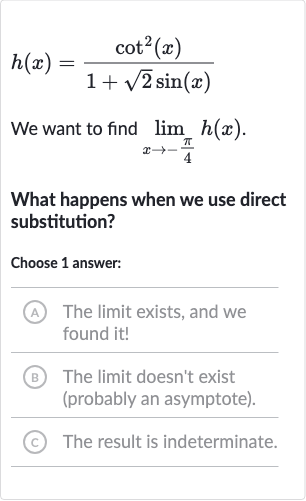AI tutor
Welcome to Bytelearn!
Let’s check out your problem:

We want to find .What happens when we use direct substitution?Choose answer:(A) The limit exists, and we found it!(B) The limit doesn't exist (probably an asymptote).(C) The result is indeterminate.
Full solution
Q. We want to find .What happens when we use direct substitution?Choose answer:(A) The limit exists, and we found it!(B) The limit doesn't exist (probably an asymptote).(C) The result is indeterminate.
- Substituting into : Let's attempt to substitute with directly into the function to see what happens.
- Evaluating : We need to evaluate and . The cotangent of is the reciprocal of the tangent of . Since , .
- Evaluating : Now we square to get .
- Substituting values into : Next, we evaluate . Since and , we have .
- Division by zero and the limit: Substitute these values back into the function :This simplifies to , which is undefined.
- Division by zero and the limit: Substitute these values back into the function :This simplifies to , which is undefined.Since we have a division by zero, the limit does not exist due to a vertical asymptote at .
More problems from Domain and range of relations
QuestionGet tutor help
QuestionGet tutor help
